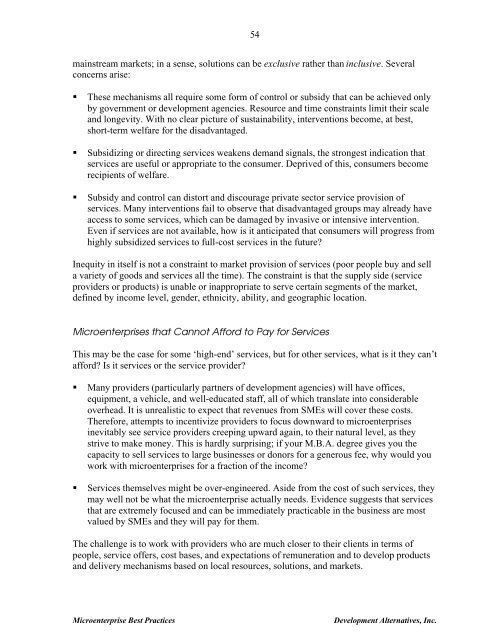BDS market development guide.pdf - PACA
BDS market development guide.pdf - PACA
BDS market development guide.pdf - PACA
Create successful ePaper yourself
Turn your PDF publications into a flip-book with our unique Google optimized e-Paper software.
54<br />
mainstream <strong>market</strong>s; in a sense, solutions can be exclusive rather than inclusive. Several<br />
concerns arise:<br />
• These mechanisms all require some form of control or subsidy that can be achieved only<br />
by government or <strong>development</strong> agencies. Resource and time constraints limit their scale<br />
and longevity. With no clear picture of sustainability, interventions become, at best,<br />
short-term welfare for the disadvantaged.<br />
• Subsidizing or directing services weakens demand signals, the strongest indication that<br />
services are useful or appropriate to the consumer. Deprived of this, consumers become<br />
recipients of welfare.<br />
• Subsidy and control can distort and discourage private sector service provision of<br />
services. Many interventions fail to observe that disadvantaged groups may already have<br />
access to some services, which can be damaged by invasive or intensive intervention.<br />
Even if services are not available, how is it anticipated that consumers will progress from<br />
highly subsidized services to full-cost services in the future?<br />
Inequity in itself is not a constraint to <strong>market</strong> provision of services (poor people buy and sell<br />
a variety of goods and services all the time). The constraint is that the supply side (service<br />
providers or products) is unable or inappropriate to serve certain segments of the <strong>market</strong>,<br />
defined by income level, gender, ethnicity, ability, and geographic location.<br />
Microenterprises that Cannot Afford to Pay for Services<br />
This may be the case for some ‘high-end’ services, but for other services, what is it they can’t<br />
afford? Is it services or the service provider?<br />
• Many providers (particularly partners of <strong>development</strong> agencies) will have offices,<br />
equipment, a vehicle, and well-educated staff, all of which translate into considerable<br />
overhead. It is unrealistic to expect that revenues from SMEs will cover these costs.<br />
Therefore, attempts to incentivize providers to focus downward to microenterprises<br />
inevitably see service providers creeping upward again, to their natural level, as they<br />
strive to make money. This is hardly surprising; if your M.B.A. degree gives you the<br />
capacity to sell services to large businesses or donors for a generous fee, why would you<br />
work with microenterprises for a fraction of the income?<br />
• Services themselves might be over-engineered. Aside from the cost of such services, they<br />
may well not be what the microenterprise actually needs. Evidence suggests that services<br />
that are extremely focused and can be immediately practicable in the business are most<br />
valued by SMEs and they will pay for them.<br />
The challenge is to work with providers who are much closer to their clients in terms of<br />
people, service offers, cost bases, and expectations of remuneration and to develop products<br />
and delivery mechanisms based on local resources, solutions, and <strong>market</strong>s.<br />
Microenterprise Best Practices<br />
Development Alternatives, Inc.














